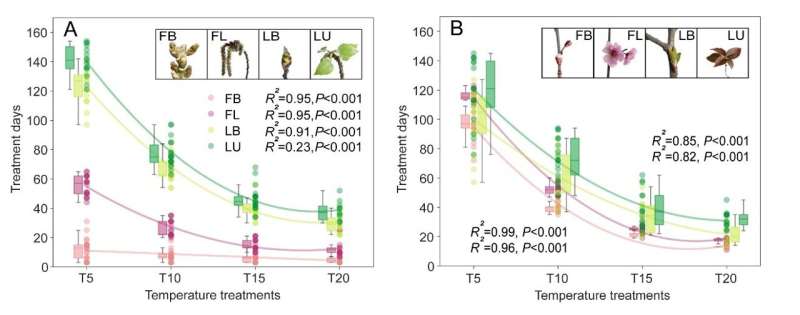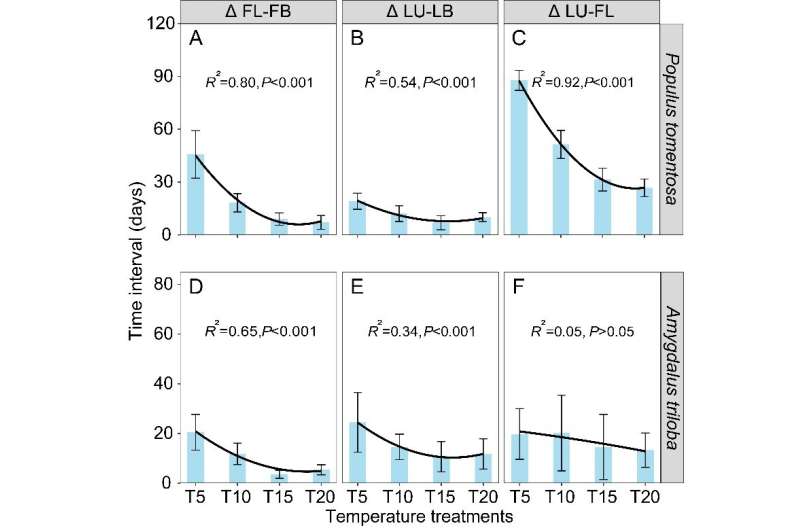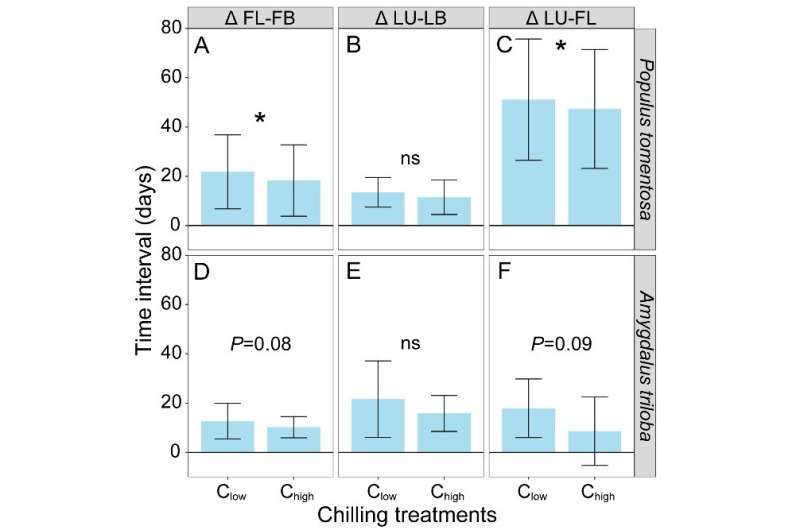The timing of warm period determines the time interval between flowering and leaf unfolding

Warming-induced shifts in vegetation phenology have substantially affected the terrestrial energy balance as well as carbon and water cycles, which in turn exert biophysical and biogeochemical feedback to the climate system. Spring phenology of temperate and boreal tree species has advanced significantly with warming in recent decades, but most previous studies focused on a single phenophase, such as flowering or leaf unfolding.
However, the phenological responses to climate change within species can vary substantially among different phenophases. Flowering (FL) and leaf unfolding (LU) are the most important phenophases that determine the plants' reproduction and vegetative growth. Both flowering and leaf unfolding occur in early spring for most deciduous species, but their responses to environmental cues are largely different according to in situ and experimental phenological observations.
Such divergent responses may alter the time interval between flowering and leaf unfolding (ΔLU-FL), which sequentially influences plants' pollen transfer efficiency, resource allocation and fitness, ultimately changing the structure and functioning of terrestrial ecosystem. In spite of its potential significance, the impact of climate change on the time interval between flowering and leaf unfolding has received limited attention.
In order to investigate the effects of winter chilling, spring warming and photoperiod on the ΔLU-FL, an experiment was conducted by Master Shuxin Wang and Dr. Zhaofei Wu (College of Water Sciences, Beijing Normal University) based on twigs collected from two flowering-first temperate tree species in Beijing, Populus tomentosa and Amygdalus triloba.

"When we compare the effect of winter and spring warming on the time interval between flowering and leaf unfolding, we surprisingly found that these two warming periods have opposite effects," says Shuxin Wang, the first author of the paper.
A warmer winter reduced chilling accumulation and subsequently resulted in a higher GDD requirement for spring phenology. A smaller increase in GDD requirement for flowering than for leaf unfolding may result in a larger advance of flowering than of leaf unfolding, thus resulting in an extended time interval between these two phenophases. On the contrary, a larger temperature sensitivity of leaf unfolding than flowering resulted in a shortened time interval between flowering and leaf unfolding.
"The changes in time interval between flowering and leaf unfolding may have substantial ecological implications. For example, it may cause asynchrony between the timing of flowering and leaf unfolding and the timing of optimal resource supply (e.g. water and nutrients), and ultimately reduce plant fitness, modify relative competition among different species and affect the structure and functioning of terrestrial ecosystem," Prof. Yongshuo Fu of Beijing Normal University points out. "However, we only focused on two flowering-first species in the present study, yet how species with different flower-leaf sequences and life strategies respond to climate change remains unclear."
"Future warming magnitudes are projected to vary across seasons, and a larger warming magnitude in winter than in spring is expected. We therefore highlight that winter warming-induced chilling reduction may extend the time interval between flowering and leaf unfolding, or at least limit spring-warming induced contraction of this interval, safeguarding or improving reproductive success and alleviating water stress," says Prof. Yongshuo Fu.

This variability can have substantial consequences for the structure and functioning of ecosystems and feedbacks to climatic systems. For a more complete understanding of phenology responses to climate change and their ecological implications, further manipulative experiments are recommended using more tree species, especially leaf unfolding-first species.
The research was published in Science China Life Sciences.
More information: Shuxin Wang et al, Climate warming shifts the time interval between flowering and leaf unfolding depending on the warming period, Science China Life Sciences (2022). DOI: 10.1007/s11427-022-2094-6
Journal information: Science China Life Sciences
Provided by Science China Press





















